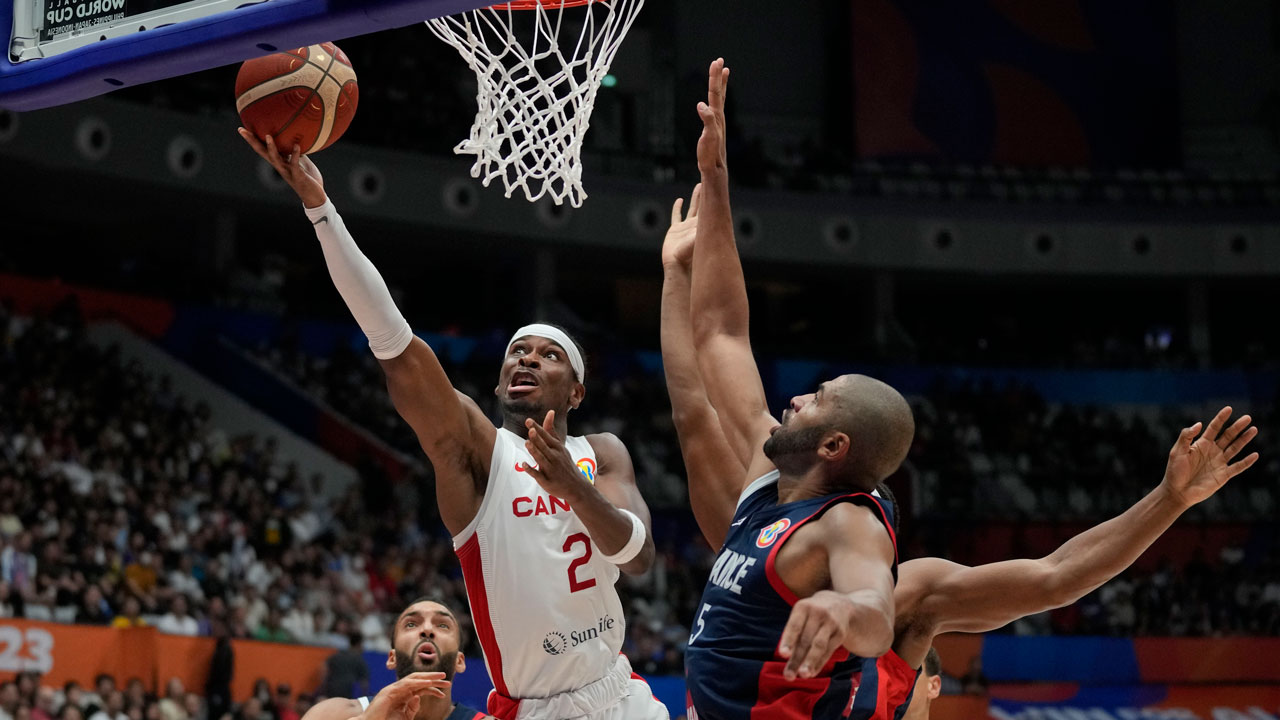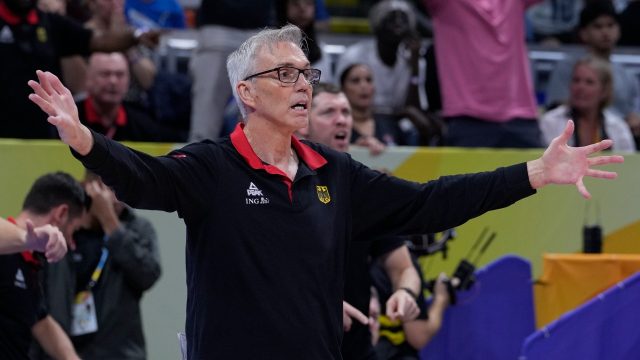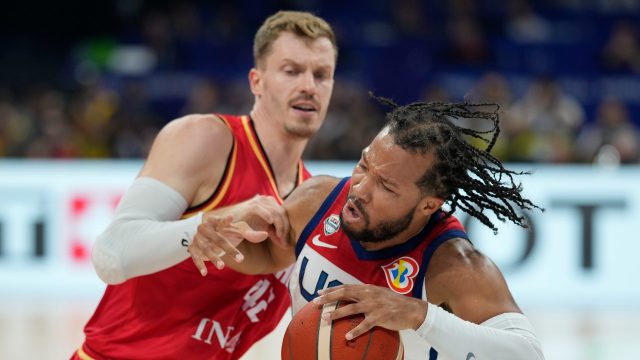
You can only hope that somewhere Jamal Murray was watching, and hopefully Andrew Wiggins and maybe a few more of Canada’s top basketball players too.
If they have been watching the Canadian men’s team at the FIBA Basketball World Cup, they had to be impressed.
This version of the Canadian men’s basketball team has been excellent; the best to have ever worn the maple leaf. It’s been borne out by their best-ever finish at a global event: no worse than fourth guaranteed, with a chance to play for bronze on Sunday.
But as much as the crew led by Shai Gilgeous-Alexander and augmented by Dillon Brooks, R.J. Barrett, Kelly Olynyk and the rest has delivered on their promise and indicated their still-untapped potential, they are not a finished product.
As their 95-86 loss to a polished, deep, big and experienced Serbian team showed, in the semifinals on Friday in Manila, the step from being good enough to compete on the world stage to being ready to win is significant.
It’s shame, too: With tournament favourites Team USA being stunned by Germany in the other semifinal, there was a path to a gold medal there to be taken, not that Germany – led by incoming Raptor Dennis Schröder (17 points and nine assists) and coached by former Canadian national team coach and player Gordie Herbert – will be a pushover for Serbia or would be for Canada.
But the whole experience illustrates both where Canada is and where it needs to be. Winning at the international level takes the entire package: talent, commitment and savvy. Canada isn’t quite there yet, even though the signs are there.
Canada has has led an odd existence at the FIBA World Cup, toggling between the role of swaggy gold-medal challenger in one breath and young upstart with a lot to learn on the other.
At times in the tournament, Canada has looked every inch the team many have projected it to be, as when it blew out a pre-tournament favourite France in its opening game, setting the tone for all that’s come since, or when it stormed back from down 12 to knock off No. 1-ranked Spain in a must-win game at the end of the group stage.
At others, Canada has looked incomplete and inexperienced, lacking answers for all the tests high-level international basketball asks.
It was apparent when Canada struggled to manage the slow-down, rope-a-dope tactics presented by Brazil in a group-stage upset that put its tournament and its hopes of qualifying for the 2024 Olympics in jeopardy, and it was on display again Friday when Serbia was able to glide through Canada all too often on offense while simultaneously choking off Canada defensively. Things looked easy for Serbia when it had the ball, and very difficult for Canada when it didn’t.
It’s a winning formula and, at this stage of its development, Canada didn’t have an antidote for it.
“These guys played really, really hard,” Canada’s head coach Jordi Fernandez said after the game. “We don’t have a lot of experience playing these games, myself first, and our group of guys. But if we keep doing what we’re doing, I think we’re going to be really good. I’m excited for our future. I’m excited for these guys and the young guys coming in.”
By most common standards, Canada was the better team heading into the game: it had more NBA experience and more NBA depth and, in Gilgeous-Alexander, it had – arguably — the tournament’s best player.
But as has been shown over and over again in FIBA competition, individual pedigree can often be trumped by experience, quick decision-making and high-end shot making. And just because a player – in this case, Bogdan Bogdanovich – doesn’t have all-star pedigree in the NBA, doesn’t mean he can’t play MVP-level basketball in his country’s jersey.
Canada was on the wrong end in all of those metrics on Friday and saw first-hand what a team that has those attributes in spades can do.
And what Serbia did was beat Canada in every facet of the basketball game.
The Serbians came into the game as the most efficient offensive team in the tournament and proceeded to take it up a notch from there against Canada as they converted 62 per cent of their field-goal chances and 45 per cent from the three.
Bogdanovich was the top-line name on Canada’s scouting report, but the leading scorer from the 2019 World Cup was largely unbothered by how Canada defended him or by who: the Atlanta Hawks reserve scored 23 points on 8-of-12 shooting, adding four assists and three steals. He often used the Canadian pressure with sharp movement off-the-ball, dragging attention with him or by simply using different elements of his platter of skills to counter whatever he faced. Sometimes, he just made tough shots.
Defensively, Serbia was able to mostly stymie Gilgeous-Alexander, though 15 points and nine assists on an “off-night” is nothing to be ashamed about. It’s just that Serbia’s individual defence on the Canadian star was detailed and on point, and it was able to limit his chances while simultaneously keeping him off the line to the extent that’s possible against one of the most adept foul hunters in the sport: Gilgeous-Alexander did make it to the line nine times, but considering he took 16 free throws against Spain and Slovenia in Canada’s last two starts, it was a win for the Serbs.
And they were able to do all of that without leaving themselves victim to too many other threats. Barrett had perhaps his best game of the tournament, with 23 points on 8-of-14 shooting, and to some extent, Barrett’s looks were because Serbia was willing to risk leaving Barrett open rather than pay attention elsewhere.
The takeaway is that while this version of the national team is one of the best in the world – before losing to Serbia, Canada had counted wins against No. 5 France, No. 1 Spain and No. 7 Slovenia on its path to semifinals – there are still steps to be taken if Canada is going to seriously contend for a gold medal next summer at the Olympics or beyond after falling to No. 6 Serbia.
This group, on its own, will get better. Just playing in the bronze medal on Sunday against Team USA will make it better. The Canadians are so young in their development – they’ve played just 12 games together under Fernandez, including five pre-tournament friendlies – that every game is a new experience that provides new feedback and new lessons.
They’ll be better at the Olympics next summer, just by the virtue of time.
But they could use a talent infusion to jump-start the process – after all most of the other top contenders will be adding key pieces for next summer, too: Serbia was without two-time NBA MVP Nikola Jokic in Manila; Latvia was without Kristaps Porzingis, among others; France will likely be adding Victor Wembanyama and potentially Joel Embiid to the mix. Team USA could turn over its entire roster.
Adding to Canada’s existing base is a no-brainer, in that context.
How might be a bit trickier. Of the 14 players named to the “summer core” by Canada Basketball in 2022 with an eye toward keeping the group together through the 2024 Olympics, nine are on the World Cup roster. Chances are all nine will have the option to return, though in the case of big man Zach Edey, there’s precedent for a rookie entering the NBA to take the summer as a development period, as No.1 overall pick Wembanyama did in France’s case.
And although Kevin Pangos wasn’t with Canada at the World Cup due to an insurance problem (he couldn’t get his contract covered due to a pre-existing injury), the situation around Cory Joseph and Oshae Brissett is a little murkier as they chose to not to play at the World Cup, which could leave their roster spots open heading into next summer.
Presuming Pangos is available, and Murray plays, Canada could conceivably still have one more roster spot available to someone not part of its summer core. If Edey chooses to take the summer to get NBA-ready, there could be two.
If that’s how it shakes out, a priority should be getting Andrew Wiggins back into the fold. Given he played for Canada at Olympic qualifying tournaments in 2015 and 2021, the hope is it wouldn’t be too hard a sell.
There’s no question that Wiggins, at his best – the versatile, switchy defender who can get his own bucket off the dribble and shoot 40 per cent from three as he has the last two seasons for Golden State – would be a perfect complement to Canada’s existing roster.
Who might be next on the list is an interesting question. Will Portland’s Shaedon Sharpe be far enough along in his development to compete for minutes in a deep pool of wings? Or would Indiana’s Bennedict Mathurin be preferred? Or maybe the size and versatility offered by Minnesota rookie Leonard Miller be a priority?
Surely, the shooting, playmaking and defensive versatility of Indiana’s Andrew Nembhard would add much-needed guard depth.
None of the decisions will be simple and even adding talent without backing out on commitments to the “summer core” will have complications, as it will inevitably mean changes in roles for those who have helped Canada to impressive heights this summer.
But as impressive as Canada has been at the World Cup, its semifinal loss to Serbia showed that there is still another level to get to. Time will help that cause, but some added talent would, too.







